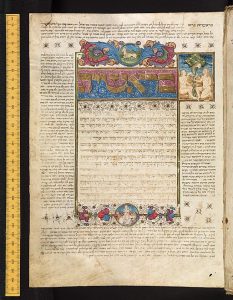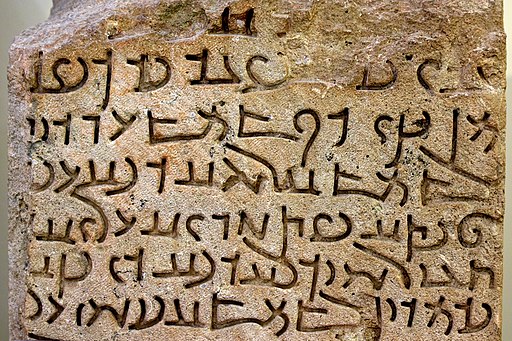2 Early Judaism and the Hebrew Canon

Pulling together the content
Materials in the Hebrew Bible began, many of them, as oral narrative. But even as early as the 11th century BCE, some of the familiar work in the Hebrew Bible began to be written down. Psalms, stories, and prophecies in small batches are mentioned as being the earliest materials that eventually ended up in the Hebrew canon.
So start here by looking at the history of what ends up in the Hebrew Bible, also known to the Christian users of this material as the Old Testament. There are three sections to the Hebrew Bible, but those sections don’t really come to be known by these titles until about the 1st century CE. Once the content of the Hebrew canon was solidified, the names of the sections were identified with the specific content.
The Sections of the Hebrew Bible
The Torah (the Teachings/Law/: Genesis, Exodus, Leviticus, Numbers, Deuteronomy) a Greek translation of this term is called the Pentateuch. Earlier believers also called these the Books of Moses.
The Neviim (the Prophets: Joshua, Judges, I Samuel, II Samuel, I Kings, II Kings, Isaiah, Jeremiah, Ezekiel, Hosea, Joel, Amos, Obadiah, Jonah, Micah, Nahum, Habukkuk, Zephaniah, Haggai, Zechariah, and Malachi. The last dozen are sometimes grouped together and called The Twelve. )
The Ketuvim (the Writings: The Books of Psalms, Proverbs, Job, Song of Songs, Ruth, Lamentations, Ecclesiastes, Esther, Daniel (although not all that is included in the Christian Canon), Ezra and Nehemiah, I Chronicles, and II Chronicles.
These three sections of writing make up the Tanakh. Because the Hebrew scholars did not divide various books in their scriptures into the smaller divisions that the Christian Scholars did with those same books (like Chronicles, for example), the book count varies. But generally, the Hebrew Bible is considered to have 24 books.
Key Takeaway: from the Jewish Virtual Library
“It should be noted that the breaking of Samuel, Kings, and Chronicles into two parts is strictly an artifact of the Christian printers who first issued the books. They were too big to be issued as single volumes. Because every one followed these de facto standards, the titles of Volume 1 and Volume 2 were attached to the names. The division of the Tanakh into chapters was also done by medieval Christians, and only later adopted by Jews.
Also, many Christian Bibles have expanded versions of several of these books (Esther, Ezra, Daniel, Jeremiah and Chronicles) including extra material that is not accepted as canonical in Judaism. This extra material was part of the ancient Greek translation of the Tanakh, but was never a part of the official Hebrew Tanakh.”
The Tanakh, https://www.jewishvirtuallibrary.org/the-tanakh.
Jewish Biblical Studies have a long and rich tradition of oral and written materials.
The Jewish Bible is written mostly in Biblical Hebrew, with a portion from the Books of Daniel and Ezra/Nehemiah written in Aramaic. Due to its sanctity, Jews stress the importance of studying the original text in its original language. No one now actually speaks Biblical Hebrew, but instead speak a modern form of Hebrew that overlaps but is not identical to the Biblical version.

Aramaic is a Semitic language, generally written in Hebrew script, and is believed to be the language that Jesus spoke. Hebrew was used mostly as a liturgical language by about the 3rd century BCE, and the people in Israel spoke Aramaic. The languages are similar, and are both considered Semitic tongues. The Aramaic versions of the Bible, or Targum, are a collection of translations written in the Jewish dialect of Palestinian Aramaic. They originate in the custom, from that era where Aramaic was the every day language, of translating the Hebrew text being read orally verse-by-verse into Aramaic during public readings of the Hebrew, and thus vary significantly in context.
The oldest Targum is by Onqelos (1st–2nd century CE) and is for the most part a reproduction of the Hebrew original. Hebrew had ceased to be the spoken language in the land of Israel, having been replaced by Aramaic, the lingua franca of the region. Originally, the Aramaic translation was recited during the Torah reading in the synagogue to help the congregation understand the Hebrew text. It gained a unique sacred status across the Jewish world and is found alongside numerous manuscripts and printings of the Hebrew Bible.
The rabbis in the Talmud mandated that every Jew should review the weekly Torah reading before the Sabbath along with the Aramaic translation of Ongelos. Many medieval Biblical manuscripts include the Targum along with the Hebrew text. In some the Targum is placed alongside the Hebrew text; in others it is recorded interlineally along with the Hebrew text, verse by verse.

Isaac, Daniel. “Jewish Languages.” British Library, Discovering Sacred Texts, 23 Sept. 2019, https://www.bl.uk/sacred-texts/articles/translation-and-transmission-jewish-languages.
Saunders, Maryanne. “The Torah.” British Library, Discovering Sacred Texts, 23 Sept. 2019, https://www.bl.uk/sacred-texts/articles/the-torah.
Walfish, Barry Dov. “Jewish Bible Study.” British Library, 23 Sept. 2019, https://www.bl.uk/sacred-texts/articles/jewish-bible-studies.
“The Tanakh.” Jewish Virtual Library, https://www.jewishvirtuallibrary.org/the-tanakh.
“The Torah.” Jewish Virtual Library, https://www.jewishvirtuallibrary.org/the-torah.
“Ketuvim.” Jewish Virtual Library, https://www.jewishvirtuallibrary.org/Ketuvim.
“Neviim.” Jewish Virtual Library, https://www.jewishvirtuallibrary.org/Neviim.
the authorized and final list of books considered to be part of the Bible
English for the Hebrew section of the Bible called Torah
Pentateuch is just the Greek word meaning “the five,” and is another term for the 5 books of the Torah
Neviim, prophets were spokespeople for God. another way to describe them would be as truth tellers. They were not fortune tellers or astrologers, but those who tried to speak to people a message sent to them by God
Ketuvim--the books in the Hebrew Scriptures that spoke more to universal human living, such as proverbs, psalms, Job, Ecclesiastes--those that taught wisdom and how to live well
The Hebrew Bible, found in 3 sections: Torah, Neviim, Ketuvim
a compilation of ancient teachings regarded as sacred and normative by Jews from the time it was compiled until modern times and still so regarded by traditional religious Jews.
